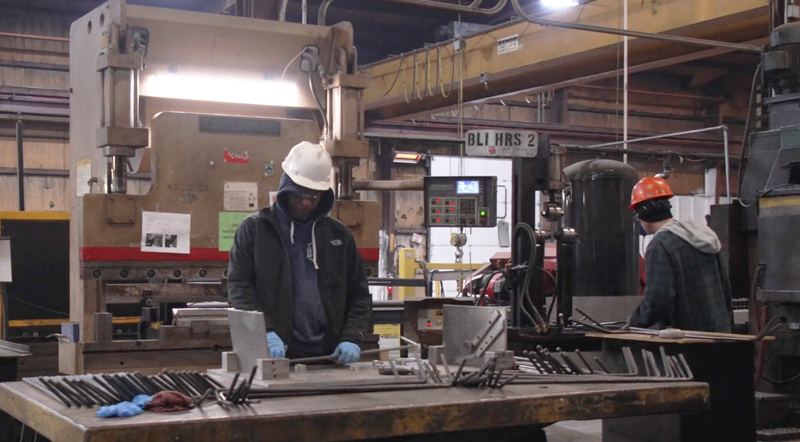The Fabrication Challenges of ASTM A516 Steel Plates—And How We Overcome Them
Thanks to their strength, toughness, and weldability, ASTM A516 grade 70 steel plates are a go-to choice for pressure vessels, boilers, and storage tanks. Like any steel type and grade, however, they present fabrication challenges that require expertise, the right equipment, and controlled processes. From welding complications to machining wear and forming difficulties, these challenges can slow production, increase costs, and impact final product quality—unless you have the right steel supplier partner.
Hydrogen-Induced Cracking
Challenge: A516 grade 70 steel is prone to hydrogen-induced cracking (HIC), especially in thicker plates or cold environments. These cracks can compromise the structural integrity of pressure vessels and storage tanks.
Our Solution: Preheating and Controlling Hydrogen Exposure
Westfield Steel takes a proactive approach to prevent hydrogen cracking. Preheating thick A516-70 steel plate sections to 200 to 300 degrees Fahrenheit (95 to 150 degrees Celsius) before welding reduces the risk of rapid cooling that leads to cracks. Low-hydrogen electrodes and storage in a controlled environment prevent moisture absorption. With expert welders following precise heat input procedures, you will get steel plates with a strong, defect-free weld every time.
Porosity and Incomplete Fusion
Challenge: Improper arc control, contamination, or poor fusion techniques can cause porosity and incomplete fusion in welds, leading to weak joints.
Our Solution: Proper Surface Preparation and Arc Control
Eliminating weld surface issues begins by ensuring all welding surfaces are thoroughly clean before welding by removing mill scale, rust, and grease. Westfield Steel welders use optimized techniques such as short arc lengths, stringer beads, and controlled shielding gas flow to create strong, clean welds.
Distortion from Welding Stresses
Challenge: Thick A516-70 steel plates, especially those for large pressure vessels, are vulnerable to warping due to residual welding stresses.
Our Solution: Stress Relief and Steps to Minimize Distortion
Advanced stress management techniques, such as backstep welding and controlled clamping, are essential first steps. When necessary, although not often, post-weld heat treatment (PWHT) at 1,100 to 1,250 degrees Fahrenheit (595 to 675 degrees Celsius) further relieves stresses and maintains material integrity.
Tool Wear and Hard Spots
Challenge: A516-70 is a low-alloy carbon steel, but it can still cause tool wear, particularly in hardened or normalized plates.
Our Solution: The Right Cutting Tools and Optimal Cutting Speeds
Westfield Steel’s machining experts use carbide and high-speed steel (HSS) cutting tools to withstand wear. Optimal cutting speeds (80-120 SFPM) and feed rates (0.005-0.010 inches per tooth) prevent excessive wear while maintaining efficiency, and applying coolant keeps tools at ideal temperatures to extend their lifespan.
Difficulties with Drilling and Boring
Challenge: Drilling holes or boring large diameters can lead to chip buildup, overheating, and tool breakage.
Our Solution: Chip Management and Lubrication for Drilling Efficiency
Cobalt drill bits support superior durability, while peck drilling cycles help break up chips and manage heat. Proper lubrication ensures smooth operation, reducing downtime and ensuring precise hole tolerances.
Poor Surface Finish
Challenge: Rough finishes or burrs can affect an ASTM A516 plate’s weldability and final assembly.
Our Solution: Grinding, Polishing, and Advanced Finishing Treatments
Flat processing and precision machining services produce high-quality surface finishes, ensuring optimal weldability. Advanced grinding, beveling, polishing, and finishing techniques refine steel plates’ surfaces, removing any hard scale or oxidation that could interfere with further processing.
Cracking or Springback During Cold Bending
Challenge: While A516-70 is highly formable, bending thick plate sections without proper preparation can cause cracks or excessive springback.
Our Solution: Preheating and Calculating Proper Bend Radius
Capable forming and stamping capabilities allow for precise bending of A516-70 steel plates, whether hot or cold. For thicker plates, preheating to 200 to 400 degrees Fahrenheit (95 to 200 degrees Celsius) improves ductility and reduces cracking risks. Calculating the correct bend radius (at least three to five times the plate thickness) minimizes stress on the material.
Buckling and Thickness Reduction
Challenge: Forming A516-70 too aggressively can lead to excessive thinning or buckling, which weakens the final product.
Our Solution: Controlled Heating, Cooling, and Forming Techniques
Controlled and gradual forming processes are more effective than single deep draws. Advanced rolling and forming equipment ensures even force distribution, while proper lubrication prevents friction-related damage.
Inconsistent Toughness After Heat Treatment
Challenge: If your steel fabricator does not carefully control normalizing or PWHT measures, heat treatment can reduce A516-70’s impact resistance.
Our Solution: Precision-Controlled Heating and Cooling
Westfield Steel tightly controls heat treatment processes to maintain optimal mechanical properties. Normalizing A516-70 at 1,650 to 1,750 degrees Fahrenheit (900 to 950 degrees Celsius) with precise air cooling while conducting PWHT at 1,100 to 1,250 degrees Fahrenheit (595 to 675 degrees Celsius) improves stress relief. Avoiding rapid cooling prevents brittleness, ensuring the final product meets industry standards.
Westfield Steel: Your Trusted Partner for Steel Plate Fabrication
ASTM A516 grade 70 is an excellent choice for pressure vessels and structural applications, but fabrication challenges can lead to costly errors without the right expertise. Westfield Steel has the experience, knowledge, equipment, and skilled workforce to overcome these challenges—delivering precision-cut, welded, machined, and formed A516-70 steel plates that meet the highest industry standards.
Our comprehensive value-added services, from cutting, machining, and forming to welding, assembly, and finishing, follow strict ASME and API standards to ensure top-tier results. Every project is unique, and Westfield Steel provides tailored steel plate solutions to meet your needs and deliver on time every time.
Contact our steel experts today to discuss your project’s A516-70 steel plate requirements and get a personalized quote.
Back
